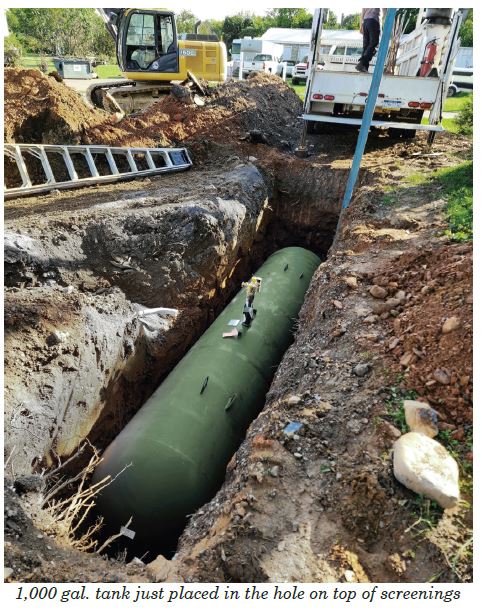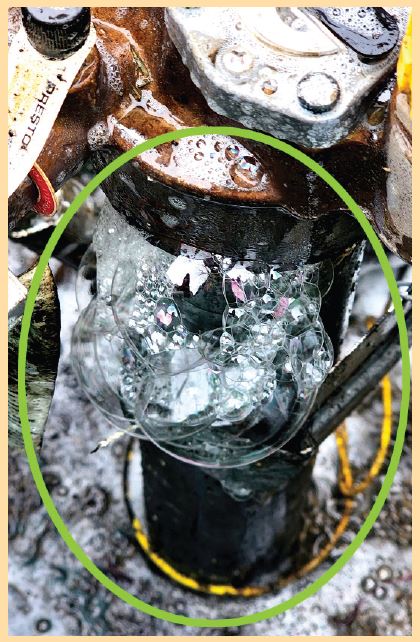Written on: March 13, 2023 by Alan Carver

The second part of this two-part series will discuss larger propane tanks, generally 250 gallon and greater, both above-ground and underground.
Like the previous article on smaller tanks, larger tanks come with their own set of codes that need to be followed. In last month’s article, we looked at propane tanks of 125 water gallon or smaller. It is worth noting again that 125 gallon tanks are the largest size allowed to be right near a building or house.
The first difference (and probably one of the most important) is that all tanks with a water gallon capacity over 125 must now be a minimum of 10′ from a house or building. The code states that it must be 10′ from the nearest liquid withdrawal, not to the steel. Therefore, the steel of the tank could be fewer than 10′ away. However, I can say that in the field, generally we try to keep the tank 10′ away to any area of the tank.
Above ground tanks
Tank sizes up to 500 gallon (generally 250 gallon and 500 gallon tanks) must not only be 10′ from the building, they must also be 10′ away from the property line. This means that if you install a 500 gallon tank only 5′ from your neighbor’s property line, it is out of code.
As with all tanks, they cannot be installed within 10′ of combustible materials, they must be 10′ from source of ignition and 25′ from open flame.
With 1,000 gallon tanks it gets a bit more complicated. A 1,000 gallon tank can be installed both 10′ away from a building, as well as the property line, but only if there are no other propane tanks of more than 125 gallon capacity within 25′ of the 1,000 gallon tank. If there is, then the number gets pushed to 25′ from the building and property line. Confusing?
Let’s break it down. Here’s an example: If I install just one 1,000 gallon tank for a warehouse, that would only need to be 10′ away from the building/property line. However, if the warehouse needs two 1,000 gallon tanks and they are tied together in the same location, the distance from the building/property line must then be 25 feet.
Another example: if the warehouse is huge, one 1,000 gallon tank can go on the right side and another 1,000 gallon tank can go on the left side. Since the two tanks are now more than 25′ from each other, they now could be 10′ from the building/property line.
Transporting
As noted in last month’s issue, propane tanks 125 gallon or fewer can be transported at full capacity, as long as you are placarded to carry over 1,001 lbs. or over (gas and steel combined).
Tanks of 250 gallon or more can only be transported at 5% or less capacity, per DOT standard. The only exception is when removing a tank from a customer’s house. If unable to remove the fuel, you can transport the tank over the 5% capacity, as long as you have the special paperwork required and go right to your bulkplant yard to drop it off.
Underground Tanks
Generally, most of the same rules apply with underground tanks as they do with above-ground tanks.
Any underground tank of 2,000 gallon or fewer must be 10′ from a building and property line, as well as 10′ from a source of ignition.
Installing an underground tank comes with its own set of challenges and there are codes and steps to follow that will ensure the safety and longevity of the tank.

When installing an underground tank, after the hole is dug, a layer of screenings is put down on the bottom to place the tank on. Screenings can be tiny, thin pieces of stone or sand, for example. Once a tank is set down, the sides, and even the top, is filled in with more screenings. The purpose of the screenings/sand is twofold. First, it allows for better water drainage. If enough water pools around the tank and has nowhere to go, there is a possibility that the tank can float up to the surface. That has happened, believe it or not. Second, the screenings/sand around the tank protect it from rocks and debris while being back-filled in.
When putting a metal tank into the ground, moisture and corrosion (which equals rust) can happen. We counteract this problem by placing anode bags in the hole near the tank, which get buried, as well. The anode bags come attached with a wire. That wire goes back to the tank, where it gets attached to a nut on the stem of the tank. This anode helps/prevents corrosion and electrolysis. The anode bags become the sacrificial piece and rot, rather than the tank.
For underground tanks up to 500 gallon, one anode bag is usually used, placed at the center of one side. For tanks that are larger, two anode bags are used. Typically they would be placed cater-cornered on opposite sides of the tank. Both wires would lead back to the tank and be tied in. It is important to wet the anode bags prior to covering them with dirt. This will speed up the charging process of the magnesium. Please note that an anode test needs to be conducted every three years after installation. If the test fails, a new anode bag must be installed.
As with any propane tanks, whether large or small, above- ground or in-ground, following codes and guidelines are essential for proper function and safety. Always follow local codes/guidelines, as well as the Federal codes outlined in NFPA58. ICM

Here is an example of how important it is to be in tune with what you are doing. If something doesn’t look or feel right, trust yourself and check it out. I went to a customer’s house to fill their 1,000 gallon underground tank. This was my first visit there. I flipped open the lid and immediately smelled gas (which should never be the case). I got my leak detector spray and sprayed all the fittings where the copper line comes in to the lid and is connected to the regulator. I saw no bubbles or signs of a leak initially, which was suprising due the overwhelming smell of gas.
So, I took my bottle and dumped quite a bit of liquid all over the top of the stem of the tank and soaked the whole area. Almost instantly, I saw the problem. As shown in the picture, the junction where the top brass section that screws onto the threads at the top of the stem, was leaking.
To fix this, we first had to drain/empty the tank completely so there would not be any pressure in the tank. We then dug down around the dome lid, pulled it off and had to twist off the whole head section on the tank. We cleaned up the threads and made sure they were in good condition. Then we re-pipe doped the threads and screwed the piece back on tightly with pipe wrenches. We re-purged the tank and added methanol back into the tank (methanol is used to keep moisture out of the tank). After that was complete, we then introduced some liquid propane back into the tank and sprayed again to check for leaks. Once we saw that there weren’t any leaks, we then filled the tank back to capacity.
This is just a helpful reminder to use your senses to make sure the propane system is safe and operating correctly.
